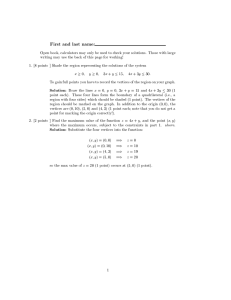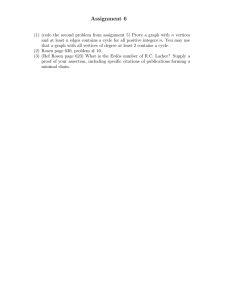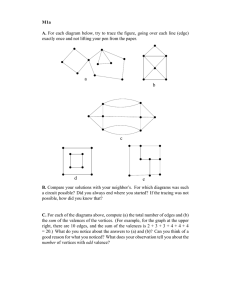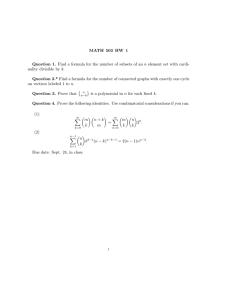MAD 3105 PRACTICE TEST 2 Information about the midterm:
advertisement
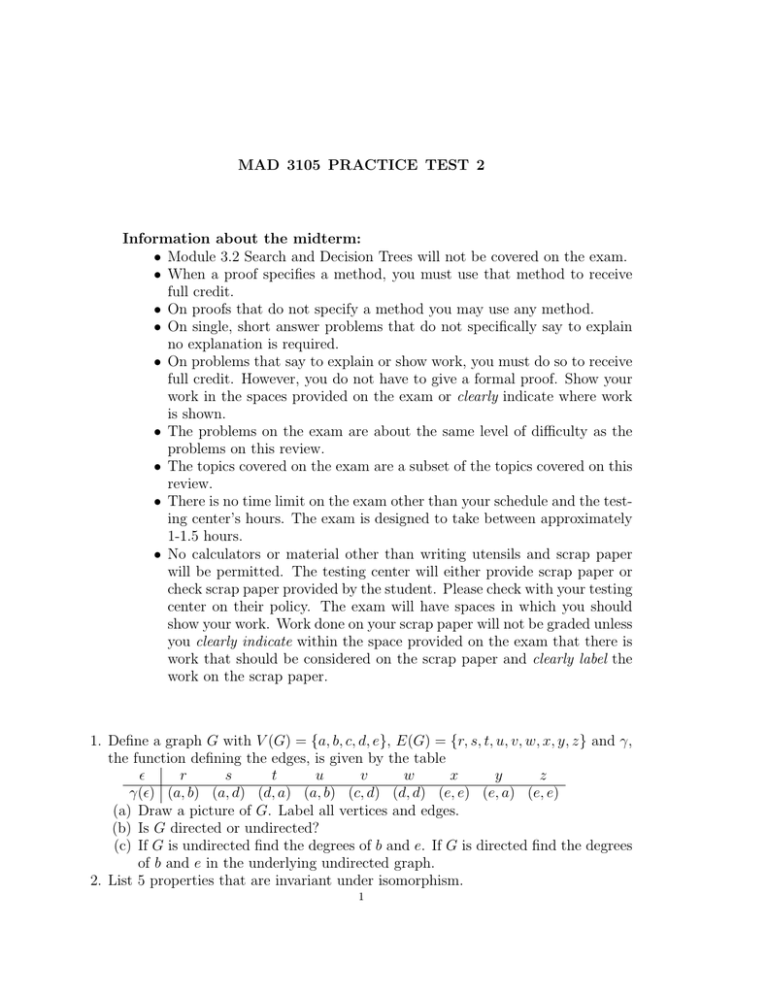
MAD 3105 PRACTICE TEST 2
Information about the midterm:
• Module 3.2 Search and Decision Trees will not be covered on the exam.
• When a proof specifies a method, you must use that method to receive
full credit.
• On proofs that do not specify a method you may use any method.
• On single, short answer problems that do not specifically say to explain
no explanation is required.
• On problems that say to explain or show work, you must do so to receive
full credit. However, you do not have to give a formal proof. Show your
work in the spaces provided on the exam or clearly indicate where work
is shown.
• The problems on the exam are about the same level of difficulty as the
problems on this review.
• The topics covered on the exam are a subset of the topics covered on this
review.
• There is no time limit on the exam other than your schedule and the testing center’s hours. The exam is designed to take between approximately
1-1.5 hours.
• No calculators or material other than writing utensils and scrap paper
will be permitted. The testing center will either provide scrap paper or
check scrap paper provided by the student. Please check with your testing
center on their policy. The exam will have spaces in which you should
show your work. Work done on your scrap paper will not be graded unless
you clearly indicate within the space provided on the exam that there is
work that should be considered on the scrap paper and clearly label the
work on the scrap paper.
1. Define a graph G with V (G) = {a, b, c, d, e}, E(G) = {r, s, t, u, v, w, x, y, z} and γ,
the function defining the edges, is given by the table
r
s
t
u
v
w
x
y
z
γ() (a, b) (a, d) (d, a) (a, b) (c, d) (d, d) (e, e) (e, a) (e, e)
(a) Draw a picture of G. Label all vertices and edges.
(b) Is G directed or undirected?
(c) If G is undirected find the degrees of b and e. If G is directed find the degrees
of b and e in the underlying undirected graph.
2. List 5 properties that are invariant under isomorphism.
1
MAD 3105 PRACTICE TEST 2
2
3. Sketch a graph of each of the following when n = 5. For what positive value(s) of
n > 2 is the graph bipartite?
(a) Kn
(b) Cn
(c) Wn
(d) Qn
4. Draw all the nonisomorphic simple graphs with 6 vertices and 4 edges.
5. Determine which of the following graphs are isomorphic.
1
2
5
a
6
b
f
e
4
3
d
c
G2
G1
1
2
5
a
e
6
8
7
f
h
g
4
3
b
d
c
G2
G1
6. Given the graph G below, how many different isomorphisms are there from G to
G. Briefly explain.
a
b
c
d
e
f
g
h
7. Can an undirected graph have 5 vertices, each with degree 6?
8. Can a simple graph have 5 vertices, each with degree 6?
9. A graph has 21 edges has 7 vertices of degree 1, three of degree 2, seven of degree
3, and the rest of degree 4. How many vertices does it have?
10. How many edges does a graph with 5 vertices have if 2 of the vertices have degree
3, 1 vertex has degree 2, and the rest of the vertices have degree 1?
11. Let S be a set of simple graphs and define the relation R on S as follows:
Let G, H ∈ S. Then (G, H) ∈ R if and only if G ' H.
This is equivalent to
Let G, H ∈ S. Then (G, H) ∈ R if and only if there exists an isomorphism
f : V (G) → V (H).
Prove this relation is an equivalence relation.
MAD 3105 PRACTICE TEST 2
3
12. Suppose G and H are isomorphic simple graphs. Show that their complimentary
graphs G and H are also isomorphic.
13. Give the number of cut vertices and cut edges of the following graphs.
(a) Kn , n ≥ 2
(b) Wn , n ≥ 3
(c) Km,n , m, n ≥ 1
14. For what values of n does each graph have (i) and Euler circuit? (ii) a Hamilton
circuit?
(a) Kn
(b) Cn
(c) Wn
(d) Qn
15. Does the Theorem given imply the graph below has a Hamilton circuit?
a
b
d
c
e
f
Theorem (Ore’s Theroem). If G is a simple graph with n vertices with n ≥ 3
such that deg(u) + deg(v) ≥ n for every pair of nonadjacent vertices u andv in G,
then G has a Hamilton circuit.
16. Draw all the nonisomorphic (unrooted) trees with 6 edges.
17. Draw all the nonisomorphic rooted trees with 4 edges.
18. Given G is a finite simple graph. Give six different completions to the sentence.
G is a tree if and only if . . .
19. Answer the following questions. Explain.
(a) How many leaves does a full 3-ary tree with all leaves at height 4 have?
(b) How many leaves does a 3-ary tree have if it has 15 parents and every parent
has exactly 3 children?
20. Prove
(a) Prove that every connected graph with at least 2 vertices has at least two
non-cut vertices.
(b) Prove a connected graph with n vertices has at least n − 1 edges.
(c) Prove a finite graph with all vertices of degree at least 2 contains a cycle.
(d) Prove a graph with n vertices and at least n edges contains a cycle for all
positive integers n. You may use that a graph with all vertices of degree at
least 2 contains a cycle.
(e) Prove the complimentary graph of a disconnected graph is connected.
MAD 3105 PRACTICE TEST 2
4
(f) A full m-ary tree with i internal vertices has n = mi + 1 vertices
(g) An m-ary tree with height h has at most mh leaves.
(h) Let G be a simple graph. G is a tree if and only if G is acyclic but the addition
of any edge between any two vertices in G will create a cycle in G.
(i) Let G be a simple graph. G is a tree if and only if G is connected but the
removal of any edge in G produces a disconnected graph.
(j) Let G be a simple graph with n vertices. G is a tree if and only if G is
connected and has n − 1 edges.
(k) Let G be a simple graph with n vertices. G is a tree if and only if G is acyclic
and has n − 1 edges.
21. Find the prefix and postfix forms for the algebraic expressions ab + c/(d ↑ 3) and
a((b + c)/d) ↑ 3 (in infix form).
22. What is the value of the prefix expression: + − ↑ 3 2 ↑ 2 3 / 6 − 4 2
23. What is the value of the postfix expression: 9 3 / 5 + 7 2 − ∗


